A staff member recently paid $2300 for a complete AR-15 carbine without regret. But you may have noticed complete uppers selling for as little as $400 during the last rounds of holiday sales and complete carbines selling for less than $700. Why pay more? One answer would be to take advantage of the latest technology in terms of manufacturing, helpful features and improved ammunition. Forged rather than cast aluminum is now the standard, and machining is more exact thanks to computer numerically controlled (CNC) automation. The efficiency and versatility of barrels have been upgraded to take advantage of heavier bullets able to land a more effective blow at greater distance. Barrels with twist rates of 1:8 inches and even 1:7 inches have replaced the original-issue lands and grooves that spun the bullets at a rate of 1:9. Handguards are now modular platforms for lights, lasers, and sights, and ambidextrous fire controls are becoming more popular as well.
With the desire for a more up-to-date AR-15, we went shopping and found that we didn’t have to break the bank — just get comfortable within a price range of about $900 to $1250 dollars. What we came up with was three AR-15s with upgrades that distinguished them from more traditional models.
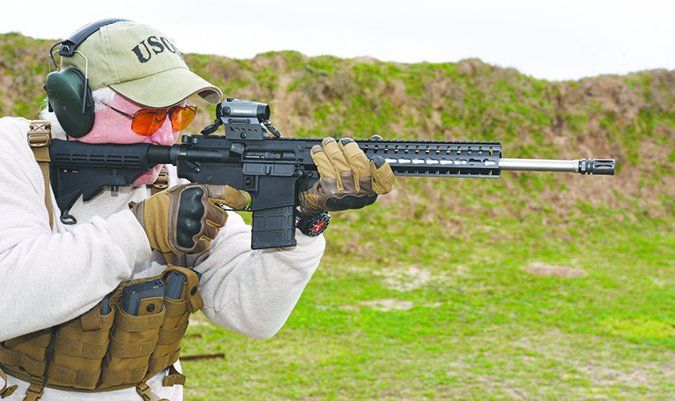
The $1000 CMMG Mk4T may still use the M1 buttstock and grip, but the 416 stainless-steel barrel offered a 1:7 twist on the inside and a bead-blast finish on the outside. The free-floated handguard offered Keymod machining on three sides, and the Picatinny top rail extended 11 inches from the receiver.
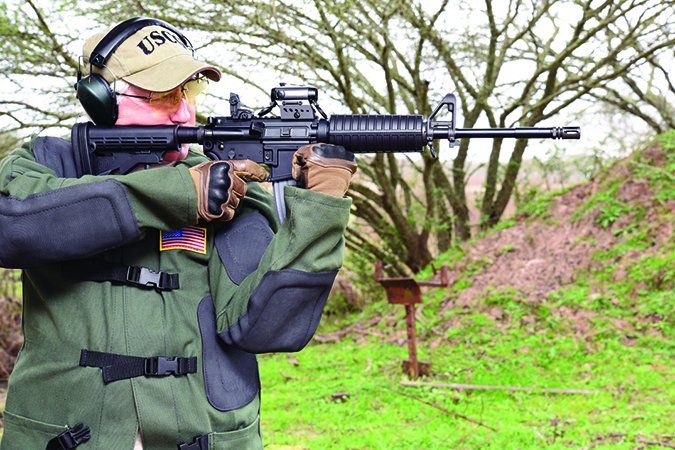
At first glance, the $1250 SIG Sauer RM400 Classic looked like a standard model with only a flat-top rail above the receiver to break up the profile. But the safety and the magazine release were ambidextrous. Barrel-twist rate was 1:7, and breaking down the rifle revealed a reduced-mass hammer.
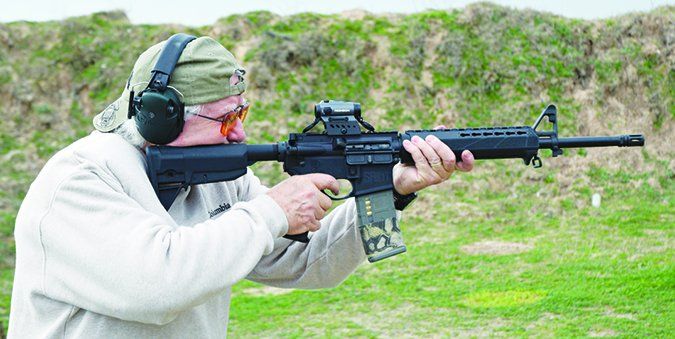
Springfield Armory’s $899 Saint, the manufacturer’s first AR-15, was treated to a Bravo Company BCM Gunfighter stock and Keymod handrail. Takedown revealed nickel-boron coating of hammer and trigger components, plus a tension screw to fix any gap between the upper and lower ends of the rifle. Barrel-twist rate was 1:8. All three-rifle barrels were marked 5.56 NATO.
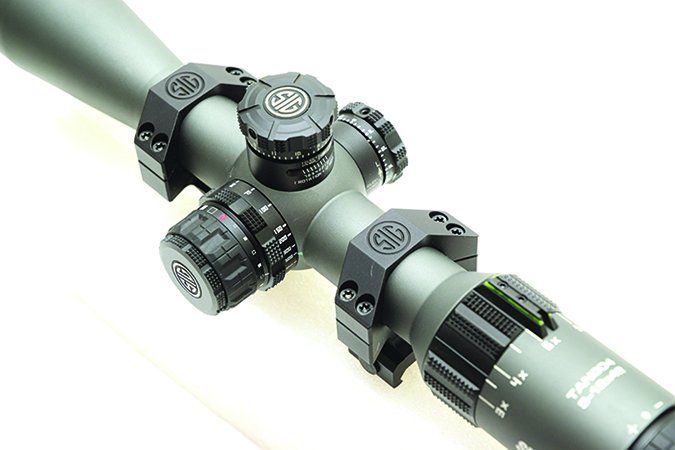
To find out if any of the above added up to improved performance, we tested for accuracy from the 100-yard line at American Shooting Centers in Houston. To find out what it was like to operate these guns at speed, we visited the Impact Zone Range in Hempstead, Texas for some timed close-quarters fire. For our distance work we mounted a SIG Sauer 3-12x42mm Tango4 optical scope ($900 MSRP). At the Impact Zone Range, our rifles shared a $420 1x20mm SIG Sauer Romeo 4b Compact Scope with a tiny 2-minute-of-angle red dot.
Choice of ammunition for AR-15s used to be limited by the 1:9-inch-twist barrel. Maximum bullet weight was considered to be 69 grains. We tested our 1:7/1:8-twist-barreled carbines with 60-grain V-Max 223 Remington rounds plus 5.56mm ammunition topped with 69-grain OTM (open-tipped match), 77-grain OTM, and 77-grain TMK (tipped Match King) rounds from Black Hills Ammunition. We also tested with 77-grain OTM 223 Remington rounds manufactured by SIG Sauer.
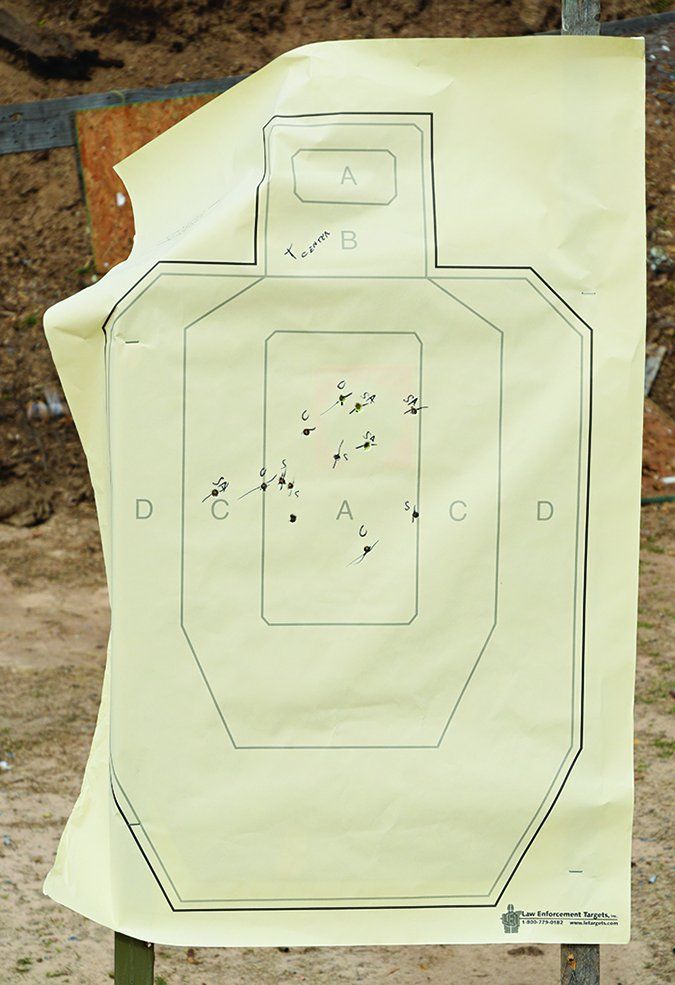
Our action test was designed to tell us more about trigger response and maneuverability than could be culled from a static benchrest session. We set up a three-target array with just 10 feet between each target. To change the shooter’s perspective and in effect reduce target area, we staggered the targets. Target-left was placed 5 yards downrange, target-right 7 yards downrange, and the center target 10 yards downrange. With the shooter lined up on the center target, the object was to land as many hits as possible into the central A-zone of each paper target within a fixed 10-second time limit. The A-zone measured 11 inches tall and about 5.75 inches wide. Upon an audible start signal, the shooter raised the carbine from low ready (about a 30-degree angle to the horizon), switched off the safety, and engaged each target with only one round before moving on. Target order was dictated as a circuit of left, center, right, left, center, right, and so on. This test was performed cold, “one and done” with no makeups. Keeping all the shots inside the A-zone was important, but for our purposes we wanted to know what characteristics were helping or hindering the shooter. Let’s see if our money was well spent.
5.56MM NATO & 223 Remington Range Data
| Black Hills 223 Remington 60-gr. V-Max New Manufacture | SIG Sauer RM400-16BC | CMMG MK 4T | Springfield Armory Saint 916556B |
| Average velocity | 2738 fps | 2726 fps | 2756 fps |
| Muzzle energy | 999 ft.-lbs. | 990 ft.-lbs. | 1012 ft.-lbs. |
| Average group | 0.6 in. | 0.8 in. | 1 in. |
| Black Hills 5.56mm NATO 69-gr. OTM New Manufacture | |||
| Average velocity | 2770 fps | 2761 fps | 2800 fps |
| Muzzle energy | 1176 ft.-lbs. | 1168 ft.-lbs. | 1202 ft.-lbs. |
| Average group | 1.1 in. | 1 in. | 1 in. |
| Black Hills 5.56mm NATO 77-gr. OTM New Manufacture | |||
| Average velocity | 2599 fps | 2598 fps | 2635 fps |
| Muzzle energy | 1155 ft.-lbs. | 1154 ft.-lbs. | 1187 ft.-lbs. |
| Average group | 0.9 in. | 1.2 in. | 0.8 in. |
| Black Hills 5.56mm NATO 77-gr. TMK New Manufacture | |||
| Average velocity | 2670 fps | 2659 fps | 2699 fps |
| Muzzle energy | 1219 ft.-lbs. | 1209 ft.-lbs. | 1246 ft.-lbs. |
| Average group | 1 in. | 1.1 in. | 1 in. |
| SIG Sauer 223 Remington 77-gr. OTM Match Grade Rifle | |||
| Average velocity | 2376 fps | 2345 fps | 2440 fps |
| Muzzle energy | 966 ft.-lbs. | 940 ft.-lbs. | 1018 ft.-lbs. |
| Average group | 1 in. | 0.9 in. | 0.9 in. |
| To collect accuracy data, we fired 5-shot groups from a sandbag rest. Distance: 100 yards. We recorded velocities using an Oehler 35P chronograph, with the first sky screen set 10 feet from the muzzle. | |||
CMMG Rifle, MK4T 5.56mm, SBN, CO, 5.56mm NATO, $1000
GUN TESTS GRADE: B

Looking past the outdated grip and buttstock, this is a very good rifle that deserved a much better trigger.
| ACTION | Semi-auto, direct impingement |
| OVERALL LENGTH | 32.25 to 35.4 in. |
| OVERALL HEIGHT (w/o scope) | 7.3 in. |
| WEIGHT UNLOADED | 6.1 lbs. |
| WEIGHT LOADED | 7.6 lbs. |
| UPPER RECEIVER | Forged 7075-T6 aluminum |
| LOWER RECEIVER | Forged 7075-T6 aluminum |
| BARREL LENGTH | 16.1 in.; 1:7 twist |
| MUZZLE DEVICE | Birdcage-style flash hider |
| BUTTSTOCK | M4-carbine type, adjustable |
| BUTTSTOCK LENGTH OF PULL | 10.4 to 13.4 in. |
| HANDGUARD | KeyMod, Picatinny |
| MAGAZINE | Detachable |
| REAR SIGHT | NA |
| FRONT SIGHT | NA |
| SIGHT RADIUS | NA |
| TRIGGER | 7.2 lbs., single stage |
| SAFETY | Thumb safety |
| CARTRIDGE CASE DEFLECTOR | Yes |
| DUST COVER | Hinged |
| FORWARDS ASSIST | Yes |
| WARRANTY | Lifetime |
| TELEPHONE | (660) 248-2293 |
| WEBSITE | CMMGInc.com |
| MADE IN | USA |
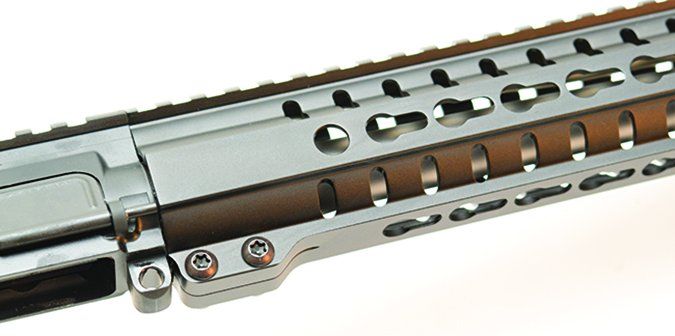
The CMMG Mk4T was the tale of two rifles. The upper, including the mix of Picatinnny and Keymod rail, was more modern than the lower, which offered more traditional components, such as the plastic grip with single finger groove and the buttstock that was sans any padding. The only upgrade we spied was a relief in the takedown pin that helps keep the punch, or bullet tip, from sliding off under pressure. But that’s not really new, either. The buttstock was properly applied and showed only the slightest wiggle. Soldiers and law enforcement who wear plates or body armor might not complain about the bare-plastic buttplate, but most shooters will want something more friendly. We applied a snap-on buttpad from Limbsaver and was pleasantly surprised at how much more comfortable it was to shoot. For sling attachment there was a fixed steel sling loop at the heel of the butt plate, or you could utilize the slot that ran parallel to the buffer tube beneath the cheek piece. There was, however, a relief on each side of the handguard about 2.5 inches ahead of the receiver for attaching a quick detach (QD) button-style sling loop. The CMMG’s single-finger-groove plastic grip is almost extinct because the divider can be uncomfortable and never really seems to be in the right place.
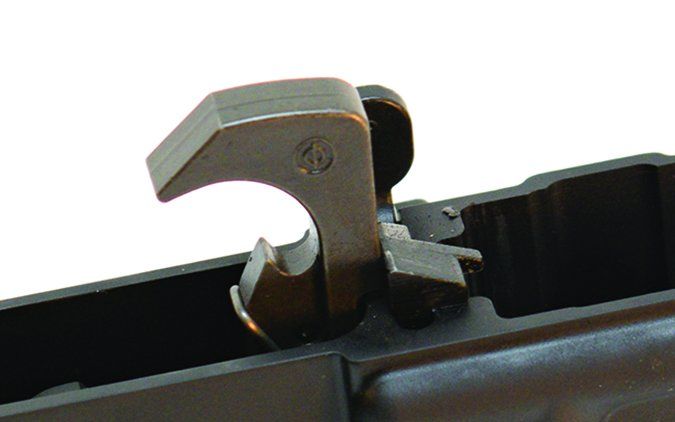
The fit between the top and bottom end of the CMMG Mk4T was admirably tight, yet the takedown pin was easy to operate. Detent at the safety was heavy and secure without any rough edges. Working the charging handle was smooth and revealed no linear movement. We did, however, find the bolt catch to be weak. American Shooting Centers is a public range, and placing the rifle in the racks during cease fires with the bolt locked open required care because any impact to the buttstock would release the bolt. The other rifles did not suffer this complaint.
From the beginning, we discovered an inordinate amount of creep in the trigger. So much so that we almost took to calling it a three-stage trigger. Operating the trigger in a controlled press, the trigger seemed to find two stopping points before finally breaking a shot. As our tests continued and the trigger broke in, we sometimes experienced only one stopping point before break. About every 20 to 25 shots, the trigger would pull straight through. In measuring trigger-pull weight, we arrived at an average of about 7.2 pounds. However, the range in resistance spanned from about 6.75 pounds to almost 8.0 pounds. Over ten trigger pulls we never got the same reading twice. And yet, accuracy from the bench was on par with our other test carbines.
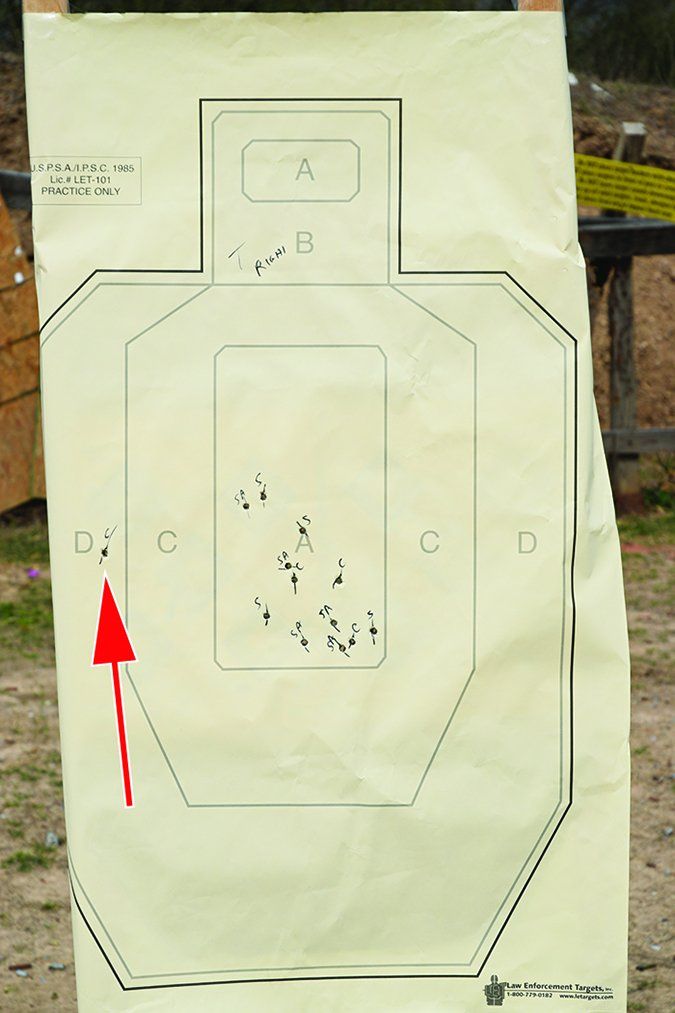
The art of shooting groups from support is about being patient. Our days at the range were somewhat windy, so waiting for a lull before releasing a shot was standard procedure. Taking into account the creep in the CMMG trigger, we patiently worked our way to the break. The result was sub-MOA groups (less than 1 inch center to center) from two of the five test ammunitions, including our lightest bullet and our heaviest. The Black Hills 60-grain V-Max rounds produced 0.8-inch-wide groups, and the 77-grain SIG Sauer rounds printed 0.9-inch-wide groups. All in, our CMMG rifle displayed 1-MOA accuracy on average for all shots fired, despite our difficulties with the trigger.
During our action tests, we landed four A-zone hits on targets left and center. The target to our right showed three A-zone hits and a stray shot in the D-zone, furthest from center. The test shooter said he was on target inside the A-zone, but the trigger didn’t respond. He called it a stutter. In the confusion the shot was released off line or as one might say, out of time.
Our Team Said: The CMMG Mk4T showed extremely good balance. It was very easy to move quickly, and the gun always felt light. We really liked the handguard. Comfortable to hold, the handguard offered the most versatility of our three rifles. We also liked the bead-blast finish on the barrel. The old-fashioned buttpad didn’t bother us because it was properly fit, but we’d definitely change out the grip. If the Mk4T had either of the triggers found on the SIG Sauer or Springfield Armory carbines, it might have been the accuracy champ of this test.
SIG Sauer M400 Classic RM400-16B-C 5.56mm NATO, $1250
GUN TESTS GRADE: A-

Extraordinary accuracy. Featured one of the most consistent triggers we’ve tried and costly ambidextrous controls. A free-float handguard would likely make this the perfect carbine.
| ACTION | Semi-auto, direct impingement |
| OVERALL LENGTH | 32.25 to 35.5 in. |
| OVERALL HEIGHT (w/o scope) | 8.5 in. |
| WEIGHT UNLOADED | 6.6 lbs. |
| WEIGHT LOADED | 8.1 lbs. |
| UPPER RECEIVER | Forged 7075-T6 aluminum |
| LOWER RECEIVER | Forged 7075-T6 aluminum |
| BARREL LENGTH | 16 in.; 1:7 twist |
| MUZZLE DEVICE | Birdcage-style flash hider |
| BUTTSTOCK | M4-carbine type, adjustable |
| BUTTSTOCK LENGTH OF PULL | 10.4 to 13.4 |
| HANDGUARD | 2-piece polymer |
| MAGAZINE | Detachable |
| REAR SIGHT | Flip up, single aperture |
| FRONT SIGHT | A1-type, fixed |
| SIGHT RADIUS | 14.75 in. |
| TRIGGER | 7.6 lbs., single stage |
| SAFETY | Thumb lever |
| CARTRIDGE CASE DEFLECTOR | Yes |
| DUST COVER | Hinged |
| FORWARD ASSIST | Yes |
| WARRANTY | Limited lifetime |
| TELEPHONE | (603) 610-3000 |
| WEBSITE | SIGSauer.com |
| MADE IN | USA |
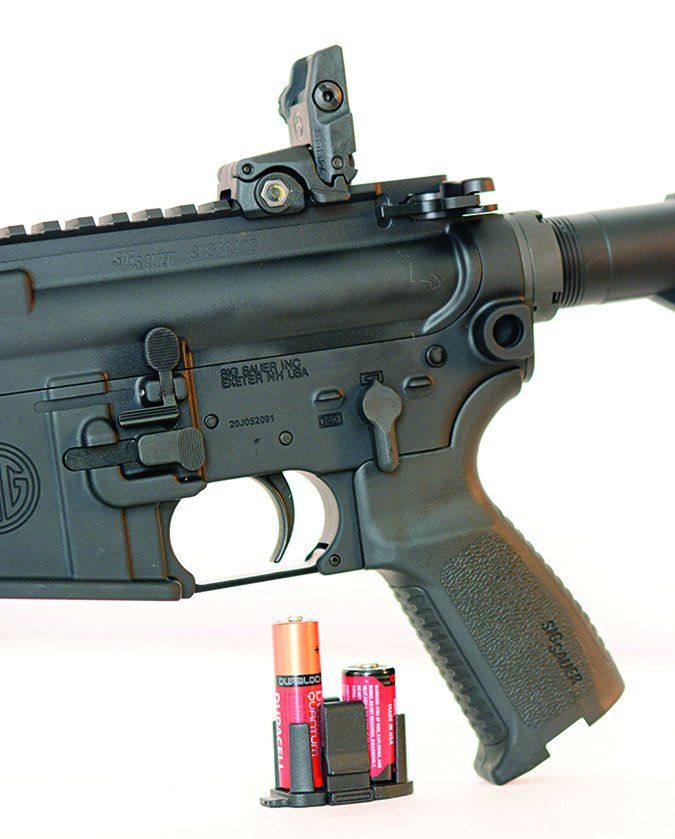
With its A1 front-sight assembly, two-piece plastic handguard and M4 buttstock, the M400 Classic did not appear to be a carbine with the type of upgrades we were looking for. But upon closer inspection, we noticed that the safety and magazine release were ambidextrous. The buttstock, although appearing very much in the M4 tradition, was modified to offer holes on each side for a quick-detach sling loop. The metal loop at the heel of buttplate was free swinging. There was another location for a QD sling from either side at the rear of the receiver just below where the buffer tube was attached. The grip was certainly not traditional, offering a very friendly profile, including a pinkie ledge, at the bottom and an extended backstrap up over the web of the hand. The upper circumference was reduced, guiding the index finger to the trigger. The bottom of the grip was removable, and there were fittings to hold popular batteries such as the CR123 or AA inside. A Magpul dual split aperture flip-up rear sight was attached to the top rail that ran the length of the receiver. Spring loaded at rest, there was a platform on each side that released the sight instantaneously to its vertical position.
The ambidextrous controls worked quite well, and the safety lever on the off hand did not interfere with the shooter, be he right-handed or left-handed. Operation was very smooth and secure. Magazine release from the left side was a little easier if pressure was applied more toward the rearward edge than over the center of the button. One by-product of this arrangement was an extension of the lower portion of the bolt lock/release lever. Whereas releasing the bolt is aided by the larger platform, setting the lock means pressing down on the smaller end. If we were to describe the bolt lock/release assembly as a seesaw, the typical lower end could be seen as being constructed without the seat. On the M400, there is an extension that adds surface area in an L-shape, making it much easier to operate.
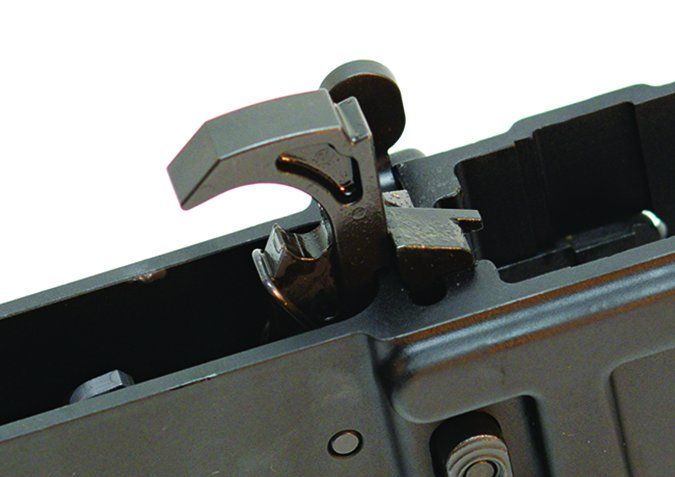
While the plastic handguard and the buttstock showed a little bit of play, fit and function of the more important parts of the M400 Classic were exceptional. The trigger presented a crisp break at about 7.6 pounds of resistance with barely an ounce or two in variation from shot to shot. Shooting the Black Hills 60-grain V-Max 223 ammunition, we were rewarded with five-shot groups that measured an average of just 0.6 inch across. Our best-of-test group measured 0.4 inch across. The Black Hills 77-grain OTM rounds were next best, showing an average five-shot group measuring about 0.9 inch. All remaining rounds produced 1-inch groups.
During our action tests, we found the fixed front sight a little distracting, even though we had it aligned (co-witnessed) with our Romeo4 red-dot sight. Nevertheless, we were able to score A-zone hits with all 12 rounds fired before time ran out. Thanks to the precise trigger, the shooter always felt he was in complete control.
Our Team Said: When it comes to paying more for a rifle, or any firearm for that matter, it’s easy to check off a list of features to justify a higher price tag. Whereas there is nothing special about the front sight, buttstock, or handguard, upgrades to the magazine release, safety levers, and the bolt catch are more expensive to manufacture or supply than a fancy handguard or buttstock. In addition, the fit and finish of the operational parts, most important the consistency of the trigger, makes this carbine worth the extra money.
Springfield Armory Saint ST916556B 5.56mm NATO, $900
GUN TESTS GRADE: A

The Saint is one of the most user-friendly versions of this user-friendly platform. We’d prefer a free-float sling attachment, but the Saint is handsome and well made at a good price.
| ACTION | Semi-auto, direct impingement |
| OVERALL LENGTH | 32.25 to 35.5 |
| OVERALL HEIGHT (w/o scope) | 8.8 in. |
| WEIGHT UNLOADED | 6.5 lbs. |
| WEIGHT LOADED | 8.1 lbs. |
| UPPER RECEIVER | Forged 7075-T6 aluminum |
| LOWER RECEIVER | Forged 7075-T6 aluminum |
| BARREL LENGTH | 16 in.; 1:8 twist |
| MUZZLE DEVICE | Birdcage-style flash hider |
| BUTTSTOCK | BCMGunfighter |
| BUTTSTOCK LENGTH OF PULL | 10.4 to 13.7 in. |
| HANDGUARD | 2-piece polymer |
| MAGAZINE | Detachable |
| REAR SIGHT | Flip-up, dual aperture |
| FRONT SIGHT | A1-type fixed |
| SIGHT RADIUS | 14.75 in. |
| TRIGGER | 7.75 lbs., single stage |
| SAFETY | Thumb safety |
| CARTRIDGE CASE DEFLECTOR | Yes |
| DUST COVER | Hinged |
| FORWARD ASSIST | Yes |
| WARRANTY | Limited lifetime |
| TELEPHONE | (800) 680-6866 |
| WEBSITE | Springfield-Armory.com |
| MADE IN | USA |
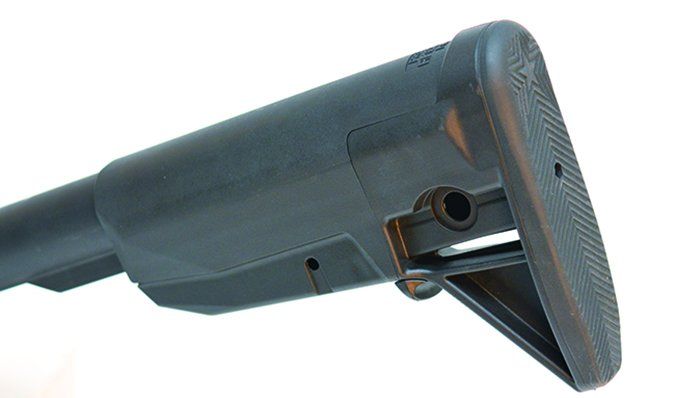
Springfield Armory of Illinois has been producing its own versions of the iconic M1A rifle for many years, but Springfield, like several other manufacturers, is known primarily as makers of handguns, or for that matter bolt-action rifles. Now more are jumping into the AR-15 market. In our view, the advertising campaign that preceded the Saint’s introduction underscored that the AR-15 is not just for the military. Rather, the AR-15 is an ideal defensive weapon necessary for the legally armed defense-conscious American. In fact, it wasn’t that long ago that SIG was in a similar position. As such, the challenge for Springfield Armory was to offer an AR-15 that distinguished itself from the competition and was affordably priced.
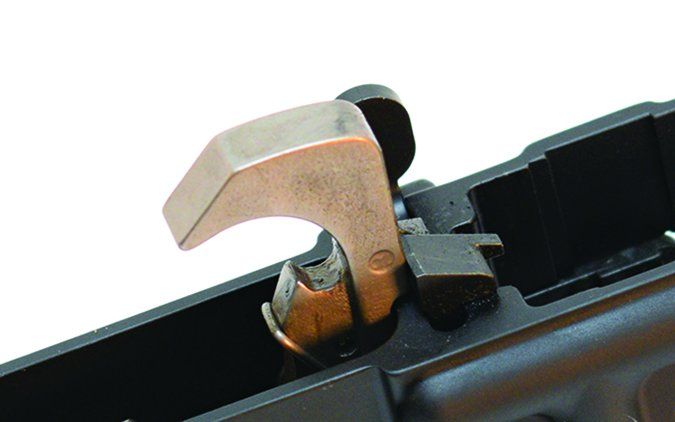
The visual theme of the Saint was that it looks to be one piece instead of an upper and lower, or as some say, it looks monolithic. The full-profile barrel creates a line that grows from a polymer handguard by Bravo Company that was flat on the sides, adorned with sections of pebbled finish for grip. Its solid visual form led us to refer to it as a forend rather than a handguard. The top rail was not really functional as a connection point, but it provided venting. One set of Keymod holes was located on the underside at 6 o’clock. Instead of being located at 3 o’clock and 9 o’clock, additional Keymod holes were located in a line upon the surface area that angled upward to the top rail (10 o’clock and 2 o’clock). Visually, this made them less obvious. We think mounting accessories in the arc between the top rail and the sides shows a lot of promise for easy control.
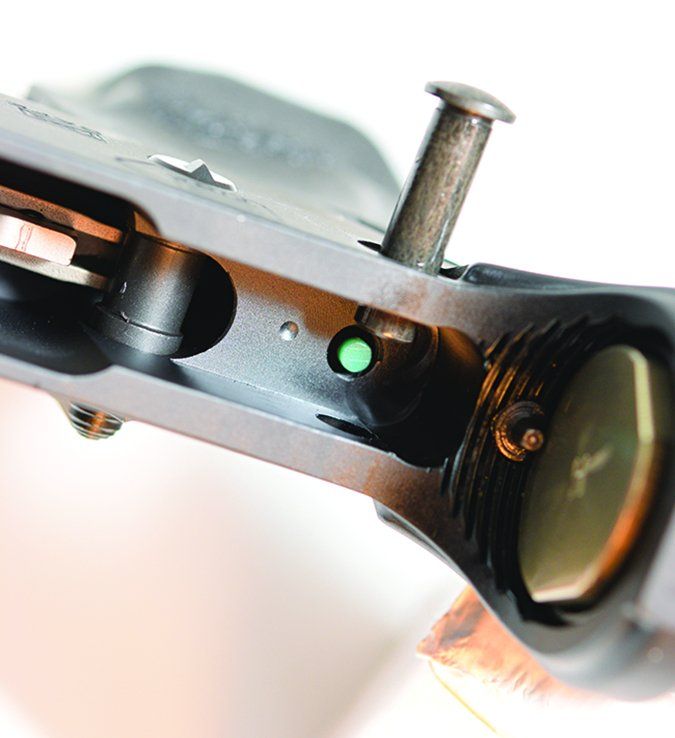
Two additional components from Bravo Company contributed to the Saint’s distinctive lines. The BCM Gunfighter grip provided a steeper angle than the others, including the Magpul grip found on the M400. The Gunfighter grip offers an extended backstrap to shield the web of the hand and the knurled side panels that provided excellent traction. The base of the grip was hinged to expose a storage space that was water resistant, thanks to a rubber gasket. The BCM Gunfighter buttstock offered sleek lines with no protruding levers that might catch on gear, such as the straps of a chest rig. The buttplate had a thin rubber pad smoothly integrated; it was more friendly to clothing or bare skin for that matter. There was a slot for threading a sling and also a hole on each side for attaching a QD sling loop. The buttstock was adjustable for length by compressing the lower panel running in line with the buffer tube. The detent spring was quite heavy and the grip necessary to compress it proved awkward. But we loved the buttpad and the overall contour of the stock. One last more subtle upgrade was the trigger guard from Bravo Company that left more room for a gloved finger without necessarily having to unlatch the bottom panel.
One of the ways that we suspect the suggested retail price of the Saint was held down was by utilizing an A1 front-sight assembly. The rear-sight assembly (sometimes referred to as BUIS or backup iron sight) was a flip-up design. Putting it into action required lifting it from its horizontal position. A spring detent pin was compressed to fold it down. Two apertures were supplied, but the larger aperture was too open, in our opinion. In use, it seemed to all but disappear.
The hammer and trigger components were treated to a silvery nickel-boron coating. We liked this because it simply wipes clean, making it easy to keep track of debris buildup and wear. Also visible with the top end hinged away was the Accu-Tite tension system consisting of a synthetic non-marring screw that mated flush beneath the bottom of the connecting lug. This removed any slack between the upper and lower ends of the rifle.
Working the Saint trigger differed from that of the SIG Sauer. Whereas the SIG Sauer presented direct pressure against a solid object, the Saint’s trigger offered a subtle compression before reaching its breaking point. We think this made the trigger a little more user friendly in that there seemed to be more time for the shooter to completely refine a shot. Higher-level shooters might prefer a hard break without overture, but it’s certainly not a distraction that will inhibit the experienced shooter. The Saint was the only carbine in the test that listed a heavy tungsten buffer among its specs, and it showed by delivering less felt recoil to the shooter.
From the 100-yard line, the Saint delivered 1.0-inch five-shot groups with the Black Hills 60-grain V-Max, 69-grain OTM rounds, and the 77-grain TMK ammunition. The Black Hills 77-grain OTM was best, producing 0.8-inch-wide groups, and the SIG Sauer 77-grain OTM ammunition produced an average five-shot group measuring 0.9 inch across. We noticed that across all choices of ammunition the Saint produced the most velocity from each round. Pushing the SIG Sauer 77-grain OTM rounds to an average velocity of 2440 fps, the SIG Sauer ammunition, marked Match Grade Rifle, was still nevertheless well below the 2750 fps printed on the box. Given the test barrel used to produce this data was likely 20 inches or more in length, we think this was still somewhat out of spec.
As was the case with the M400 Classic, the front sight was not visible with the Tango4 optical scope mounted. But it was visible when we used the Romeo4 red-dot scope. During our action test, we simply ignored the sights and read the dot. The result was more shots fired within the allotted time limit. Although the drill was shot cold, we couldn’t help but be more warmed up by the time we reached the third gun. After our run with the Saint, all three targets showed five hits. Targets left and center showed four A-zone hits, but one shot on each target was outside of the A-zone. Target right showed five A-zone shots. Between the friendly trigger, which our shooter was able to stage as we moved from target to target, and some adrenalin, we had added one full circuit, even if all 15 shots weren’t perfect.
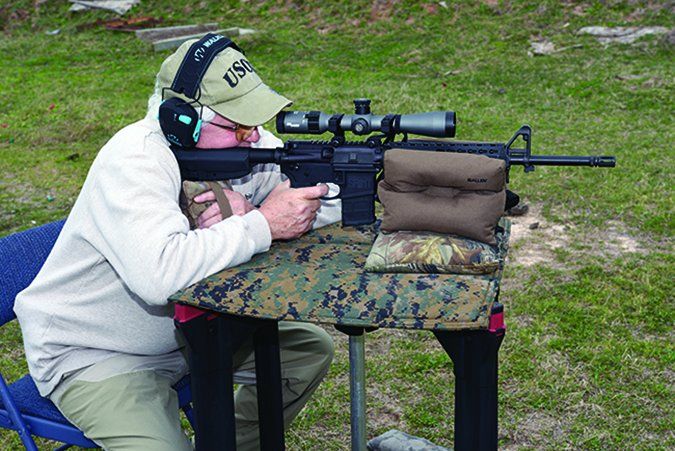
Our Team Said: Priced at $900 MSRP, the Saint should be extremely competitive for first-time buyers. Actually, there is little here that would put off the sophisticated shooter as well. Yes, we would have preferred a flat-top gas block with rail for attaching a folding front sight, and we’re not exactly sure how to connect a sling to the front end without pulling on the barrel, but we’re not sure there is much else wrong. If the buttstock was somewhat stubborn to move, it was nevertheless rock solid and more comfortable than most. So was the grip and handguard. The trigger was forgiving in any situation, and construction was first rate.
Written and photographed by Roger Eckstine, using evaluations from Gun Tests team testers.




























